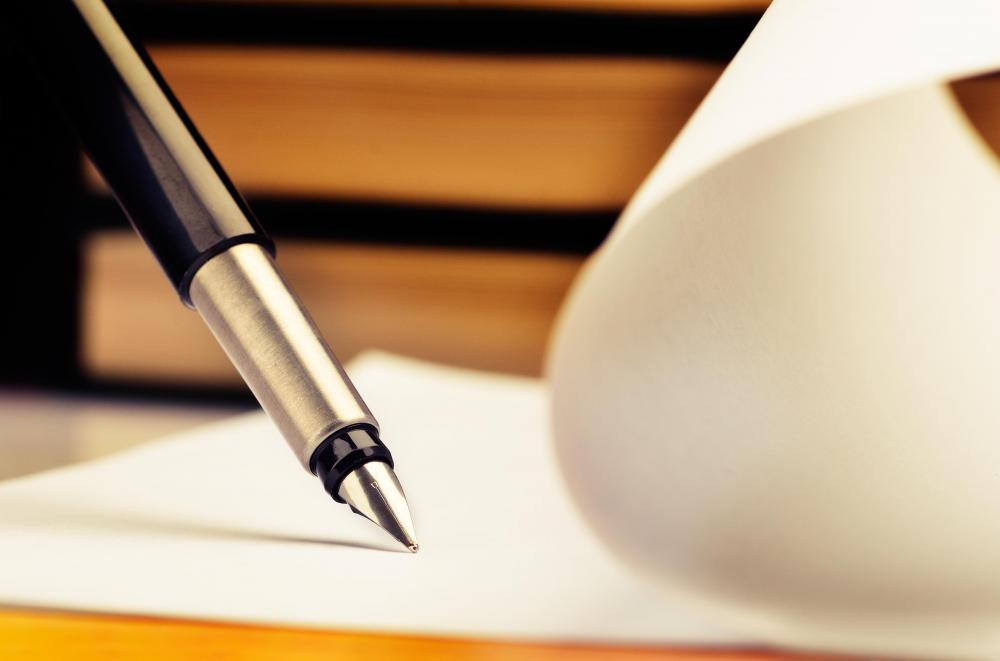At WiseGEEK, we're committed to delivering accurate, trustworthy information. Our expert-authored content is rigorously fact-checked and sourced from credible authorities. Discover how we uphold the highest standards in providing you with reliable knowledge.
What are Fountain Pens?
The fountain pen is one of many instruments in the evolution of writing. The first writing instruments were probably shaped sticks for making marks in clay. When writing evolved to a surface application of pigment, pens and brushes became required.
The first pens were bamboo tubes or birds' quill feathers. Both were cylindrical and, when cut on a slant, could be counted on to hold a drop or two of ink if dipped into it. Quill pens were the standard writing instrument throughout much of Western history -- they were cheap and supplies were plentiful. A slit cut into the sharp end of the cylinder would guide the ink, by capillary action, to the tip and thus to the paper.

Quill pens had some annoying features, however. The points, or nibs, became mushy with use and would leave blots and splatters. It was often necessary for the writer to stop and sharpen the point by cutting away the mushy part and resplitting the tip. This led to the eventual need for a new quill as the shaft was whittled away. This problem was solved with the invention of the dip pen, with a metal nib, which combined the advantages of the quill with the bonus that it never needed sharpening and with care could last indefinitely.
Fountain pens took the dip pen a step further. Named after a reservoir in the barrel which held ink, the original fountain pens were carefully filled with a tiny eye dropper.

Soon fountain pens came with a small rubber reservoir in the barrel. Pressing a button, lever or tab on the outside of the barrel would compress the bulb within. Then the fountain pen was dipped in the ink and the bulb was released to expand to its original size, creating a vacuum that would suck the ink into the bulb.
In the fifties, fountain pens were further improved with the addition of disposable pre-filled ink cartridges which were simply inserted into the barrel. Screwing the barrel to the head of the pen drove a sharpened tube into the cartridge, opening it and feeding the ink from the cartridge to the nib for writing.

Shortly after the invention of fountain pen cartridges, however, the ballpoint pen was invented and quickly overtook the fountain pen in use. Ballpoints didn't leak, as even the best fountain pens could, and applied ink evenly without blotting or sudden spurts or splatters.
Today, fountain pens are looked upon as elegant writing instruments which require a lighter touch than ballpoints or felt-tips and deliver a smooth track of shiny wet ink. Original fountain pens from their early years are highly collectible and very enjoyable to write with.
AS FEATURED ON:
AS FEATURED ON:














Discussion Comments
Fountain Pens are surely "safe" to use. However, to add to geeny's post about ingesting liquid ink: Ink is not just bitter and stainful to your mouth and inner tracts, it can actually cause severe damage to your nervous system.
'Are fountain pens safe"? Well, if one were to ingest the liquid ink (which would be relatively easy to do) I'm sure it would not taste good and would certainly stain the mouth, teeth, etc! That aside, fountain pens are much better for penmanship, as the ink flows easily and rarely clumps around the point, as ballpoint pens can. However, fountain pens do not function well on highly glossy paper, either skipping or taking a relatively long time to dry (or both). Also, take care when writing on 'carbonless' paper, as normally you don't want to apply much pressure on the nib.
Fountain pens are definitely safe to use, and have their advantages over ballpoints too (No, it's not just looking about pretty; there are really cheap fountain pens too).
Are fountains safe to use?
Post your comments